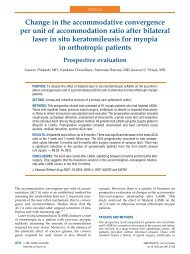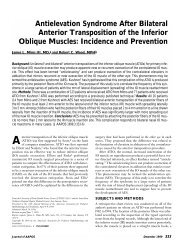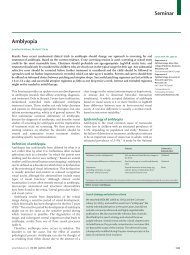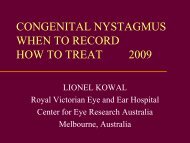What's new AAPOS 2008 - The Private Eye Clinic
What's new AAPOS 2008 - The Private Eye Clinic
What's new AAPOS 2008 - The Private Eye Clinic
Create successful ePaper yourself
Turn your PDF publications into a flip-book with our unique Google optimized e-Paper software.
included vitrectomy, capsulotomy, complications, and use of intraocular lenses (IOLs).<br />
Postoperative data included final visual acuity, refraction, number of follow-up visits, and<br />
program support for follow-up.<br />
RESULTS: Of 574 eyes of 415 children (mean age 7.1 years +/- 4.7 [SD]), IOLs were<br />
placed in 416 (87%). At least 1 follow-up was attended by 408 patients (98.3%) (mean<br />
total follow-up 3.5 +/- 1.8 months); 40% of eyes achieved a final visual acuity of 6/18 or<br />
better. Children living farther from the hospital had fewer postoperative visits (P = .04),<br />
while children receiving program support had more visits (P = .001). Factors predictive<br />
of better acuity included receiving an IOL during surgery (P = .04) and provision of<br />
postoperative spectacles (P = .001). Predictive of worse acuity were amblyopia (P =<br />
.003), postoperative complications (P = .0001), unilateral surgery (P = .0075), and<br />
female sex (P = .045).<br />
CONCLUSIONS: <strong>The</strong> results underscore the importance of surgical training in reducing<br />
complications, early intervention before amblyopia (observed in 40% of patients) can<br />
develop, and vigorous treatment if amblyopia is present. <strong>The</strong> positive impact of program<br />
support on follow-up is encouraging, although direct financial support may pose a<br />
problem for sustainability. More work is needed to understand reasons for worse<br />
outcomes in girls.<br />
ASCRS white paper. Hydrophobic acrylic intraocular lenses in children.<br />
Wilson ME Jr, Trivedi RH, Buckley EG, Granet DB, Lambert SR, Plager DA,<br />
Sinskey RM, Vasavada AR.<br />
J Cataract Refract Surg. 2007 Nov;33(11):1966-73.<br />
Summary:<br />
1. Hydrophobic acrylic IOLs have improved the intra-operative performance of pediatric<br />
cataract surgery. <strong>The</strong>se hydrophobic acrylic IOLs not only allow easier and safer<br />
implantation in small (even microphthalmic) pediatric eyes, they also help the surgeon<br />
consistently achieve the desired in-the-bag fixation in these eyes.<br />
2. We recommend hydrophobic acrylic IOL implantation in children. Implantation is<br />
usually combined with a posterior capsulectomy and an anterior vitrectomy from infancy<br />
until the age of 5 years. In children older than an infant, combined posterior<br />
capsulectomy, vitrectomy, and hydrophobic acrylic IOL implantation avoids the need for<br />
a secondary intervention in most eyes.<br />
3. In the eyes of infants, VAO (visual axis opacification) is much more common when an<br />
IOL of any type is implanted than in cases of primary aphakia, even when a posterior<br />
33
















